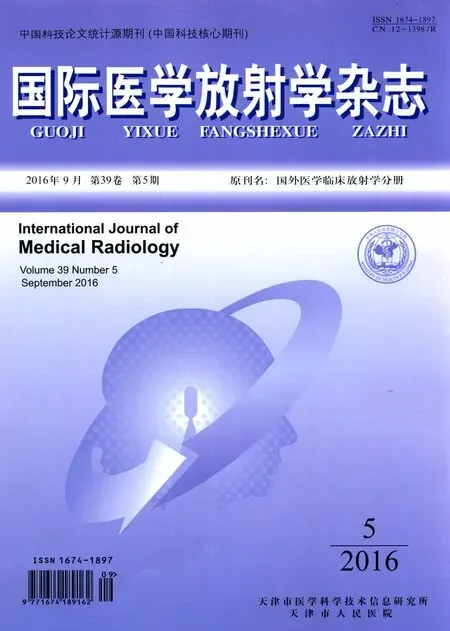特发全面性癫基底节丘脑皮质环路的多模态MRI研究进展
吕贵文 范国光*
吕贵文范国光*
特发性全面性癫日是一组非局灶性发病且没有明确病因的癫日综合征。其发病原因至今不明,之前有研究推测丘脑皮质环路起着重要作用,目前通过MRI新技术的研究,发现了基底节-丘脑-皮质环路可能影响癫日发作的产生和传播。常规MRI未能发现异常改变,而扩散张量成像、基于体素的形态测量学分析及静息态功能MRI的多模态MR新技术可从结构、体积及功能三方面发现该环路的异常改变,就其最新研究进展予以综述。
特发性全面性癫日;扩散张量成像;基于体素的形态测量学;静息态功能磁共振成像
Int J Med Radiol,2016,39(5):505-508
1 基底节-丘脑-皮质环路
前辐射冠、上辐射冠与内囊前肢、内囊后肢分别组成了丘脑前辐射以及丘脑上辐射,这些丘脑辐射连接丘脑与大脑皮质(主要是额叶皮质),丘脑辐射与大脑白质纤维束之间的连接称为丘脑-皮质环路[7-8]。Alexander等[9]提出从基底节经过丘脑将信息投射到额叶的特定区域,从而组成5条平行的又相互独立的闭合的基底节-丘脑-皮质环路。
丘脑是皮质和皮质下投射系统的主要中继站,丘脑的神经传入来源包括初级感觉、基底节、小脑和大脑的边缘系统,这些不同的传入神经到达整合和处理信息的特定的丘脑中继核团,然后将信息传递到大脑皮质[10]。所以,丘脑是皮质和皮质下结构、边缘和皮质之间的信息传递的关键所在,丘脑核团能够调节癫发作的易感性并且影响癫发作的传播。
基底节传入有2个主要输入核团:纹状体和底丘脑,它们接收从大脑皮质、边缘结构及丘脑的直接传入,然后通过直接或间接通路到达主要输出核——内侧苍白球和黑质网状部,输出核直接投射到丘脑、中脑和延髓,间接经过丘脑投射到达特定皮质及边缘系统[11-12]。Rektor等[13]研究基底节-丘脑-额叶皮质环路的认知功能(如注意力、运动准备及感觉处理等方面),发现基底节可能在认知信息处理方面起到综合性作用。最近da Silva Braga等[14]记录到GSW波放电额叶占70%,基底节占12%,表明这两个区域之间的连接为癫样活动的起始或传播起到至关重要的作用。
2 基底节-丘脑-皮质环路纤维束研究
扩散张量成像(diffusion tensor imaging,DTI)是一种无创性检测水分子扩散的大小和方向的神经成像技术,通过定量分析各向异性分数(fractional anisotropy,FA)及平均扩散率(mean diffusivity,MD)来探究纤维束的完整性。扩散峰度成像(diffusion kurtosis imaging,DKI)是DTI技术的延伸,可以检测水分子非高斯方向运动,更好地反映组织的微结构改变[15]。
Deppe等[4]首次报道了JME病人内囊前肢的FA值减低,随后,O’Muircheartaigh等[16]发现JME病人胼胝体(膝部及体部)的完整性被破坏。Focke等[17]报道了IGE病人胼胝体、皮质脊髓束、上下纵束以及辅助运动区(supplementary motor area,SMA)广泛FA减低;Lee等[18]通过DKI技术发现了IGE病人更广泛的白质纤维束的破坏,包括上下辐射冠、内囊前后肢、胼胝体(全部)、上纵束以及丘脑辐射。丘脑前辐射是丘脑和内囊前肢与前额叶皮质之间神经纤维束,其完整性的破坏,反映丘脑与双侧额叶间解剖连接的障碍,而胼胝体膝和体部主要连接双侧前额叶、前运动区以及SMA[7]。这些纤维束的破坏可以推测丘脑-皮质环路的障碍。然而,最近有研究[19]报道通过胼胝体切开术发现仅能减轻IGE的症状,但不能完全改善其症状,推测可能正是由于存在皮质下其他环路所致。
一些研究发现基底节参与丘脑-皮质环路,Keller等[20]报道了JME病人额叶白质纤维束以及壳核的FA值减低,Luo等[21]发现CAE病人双侧丘脑、壳核及左侧尾状核的MD值增加,双侧尾状核的FA值减低。这些研究的不一致性可能是由于IGE的亚型不同所致。由于不同亚型间存在互相重叠的临床表现以及缺乏特异性EEG表现,故临床区分非常困难。目前已有研究[22]利用DTI区分JME与GTCS白质纤维束破坏的差异,这提示DTI技术可能鉴别IGE的不同亚型。大多数研究没有发现DTI参数值与癫持续时间、药物治疗间的相关性,仅Kim等[23]发现发作频率与FA、MD呈正相关,这提示FA、MD可能作为潜在的生物学指标反映IGE的病理进程。基底节的研究目前相对较少,有待于以后更多大样本的研究。
3 基底节-丘脑-皮质环路体积的研究
基于体素的形态测量学(voxel based morphometry, VBM)是一种完全自动化的、公正、全面的比较脑组织结构区域差异的技术,是一种以体素为单位的形态测量学方法,可分析脑灰质体积成分的差异[24]。
大部分研究发现各个亚型IGE病人丘脑体积的减小,Kim等[25]报道的JME病人以及Huang等[26]报道的GTCS病人,其丘脑体积均有不同程度的萎缩。但丘脑的亚区域不同,Wang等[27]发现背内侧核及丘脑枕的体积减少,右侧前内侧丘脑[28]以及双侧前内侧丘脑[29]也有报道。然而也有研究[30-31]未发现JME病人以及混合-IGE病人丘脑体积的改变。虽然有研究[32]报道颞叶上中下回体积的减小,但皮质体积减小主要集中在额叶。Tae等[33]发现前额叶皮质灰质浓度下降,Kim等[25]发现内侧额叶皮质灰质体积下降,还有研究[27-28]发现额叶眶回以及额中央区域的萎缩。这些发现的不一致性可能由于VBM取决于局部灰质的平均分割,没有考虑到皮质的折叠,另外IGE的亚型不同也可能造成差异。
一些研究发现了基底节区灰质体积的减小。Ciumas等[34]发现丘脑、脑干、尾状核以及壳核体积的减小。Du等[5]发现左侧丘脑、左侧壳核、双侧苍白球体积减小,最近Luo等[21]发现双侧丘脑、壳核以及苍白球体积减小。这些研究结果均支持基底节-丘脑-皮质环路参与癫发作的调控。
4 基底节-丘脑-皮质环路功能的异常
静息态功能MRI(resting-state functional MRI,rs-fMRI)是在静息状态下,通过测量大脑自发低频(0.01~0.08 Hz)的血氧水平依赖(blood oxygenation level dependent,BOLD)波动的时间相干性来反映大脑自发神经活动。EEG-fMRI结合了EEG高时间分辨率和fMRI高空间分辨率的优点,在研究脑癫上有很大优势。
在IGE病人的EEG-fMRI研究中,BOLD信号改变与癫放电活动有关,BOLD信号增高反映癫的易化区,主要集中在丘脑、尾状核以及丘脑[35-37];BOLD信号减低结果较一致,主要集中在默认网络(default mode network,DMN)区域[38-39]。Wang等[40]用低频振幅(amplitude of low-frequency fluctuation,ALFF)技术发现前额叶皮质在0.010~0.027 Hz频带有差异,而丘脑则在0.027~0.073 Hz频带有差异,这两个区域共同在0.198~0.250 Hz波段有差异。除了大脑自发活动功能的异常外,脑的功能和结构也是密不可分的,Wang等[27]利用功能连接(functional connectivity,FC)技术,将种子点选在IGE病人丘脑背内侧核,发现双侧眶额叶皮质、尾状核、壳核和杏仁核中功能连接显著下降。Kim等[28]最近亦使用FC技术,发现IGE病人丘脑前内侧与双侧内侧前额叶和楔前叶/后扣带回功能连接下降。Luo等[6]提出基底节网络概念,并且发现IGE病人在非放电期间,双侧尾状核、壳核功能连接增强,而在放电期间功能连接更强,且增强的连接性与放电的数目正相关,因此推测基底节网络在IGE疾病中可能作为一个癫的调节器角色。
5 基底节-丘脑-皮质环路与认知障碍的关系
这些神经认知研究结果与基底节-丘脑-额叶皮质环路的功能成像结果相一致[23]。由于DTI等技术发现脑白质纤维束损伤的证据越来越多,使得临床认知区域白质受损得到越来越多的认可。但是,尚未有研究发现认知功能评分与DTI参数之间的相关性,这可能需要当认知水平下降更严重时,以及纵向研究来发现认知变化与DTI之间的因果关系,从而有利于病人的治疗及预后。
6 局限性与前景
[1]Sillanpää M,Anttinen A,Rinne JO,et al.Childhood-onset epilepsy five decades later.A prospective population-based cohort study[J]. Epilepsia,2015,56:1774-1783.
[2]Panayiotopoulos CP.Idiopathic generalized epilepsies:a review and modern approach[J].Epilepsia,2005,46 Suppl 9:1-6.
[3]Penfield W,Jasper H.Epilepsy and the functional anatomy of the human brain[J].1954,119:645-646.
[4]Deppe M,Kellinghaus C,Duning T,et al.Nerve fiber impairment of anterior thalamocortical circuitry in juvenile myoclonic epilepsy[J]. Neurology,2008,71:1981-1985.
[5]Du H,Zhang Y,Xie B,et al.Regional atrophy of the basal ganglia and thalamus in idiopathic generalized epilepsy[J].J Magn Reson Imaging,2011,33:817-821.
[6]Luo C,Li Q,Xia Y,et al.Resting state basal ganglia network in idiopathic generalized epilepsy[J].Hum Brain Mapping,2012,33: 1279-1294.
[7]Mori S,Oishi K,Jiang H,et al.Stereotaxic white matter atlas based on diffusion tensor imaging in an ICBM template[J].NeuroImage, 2008,40:570-582.
[8]Bertram EH.Neuronal circuits in epilepsy:do they matter[J].Exp Neurol,2013,244:67-74.
[9]Alexander GE,DeLong MR,Strick PL.Parallel organization of functionally segregated circuits linking basal ganglia and cortex[J].Annu Rev Neurosci,1986,9:357-381.
[10]Verghese J,Rapin I.Subcortical epilepsy[J].Neurology,2014,82: 373.
[11]Laxpati NG,Kasoff WS,Gross RE.Deep brain stimulation for the treatment of epilepsy:circuits,targets,and trials[J].Neurotherapeutics,2014,11:508-526.
[12]Middleton FA,Strick PL.Basal ganglia and cerebellar loops:motor and cognitive circuits[J].Brain Res Brain Res Rev,2000,31:236-250.
[13]Rektor I,Bares M,Kanovsky P,et al.Cognitive potentials in the basal ganglia-frontocortical circuits.An intracerebral recording study[J].Exp Brain Res,2004,158:289-301.
[14]da Silva Braga AM,Fujisao EK,Betting LE.Analysis of generalized interictal discharges using quantitative EEG[J].Epilepsy Res,2014, 108:1740-1747.
[15]Fukunaga I,Hori M,Masutani Y,et al.Effects of diffusional kurtosis imaging parameters on diffusion quantification[J].Radiol Phys Technol,2013,6:343-348.
[16]O’Muircheartaigh J,Vollmar C,Barker GJ,et al.Focal structural changes and cognitive dysfunction in juvenile myoclonic epilepsy [J].Neurology,2011,76:34-40.
[17]Focke NK,Diederich C,Helms G,et al.Idiopathic-generalized epilepsy shows profound white matter diffusion-tensor imaging alterations[J].Hum Brain Mapp,2014,35:3332-3342.
[18]Lee CY,Tabesh A,Spampinato MV,et al.Diffusional kurtosis imaging reveals a distinctive pattern of microstructural alternations in idiopathic generalized epilepsy[J].Acta Neurol Scand,2014,130:148-155.
[19]Unterberger I,Bauer R,Walser G,et al.Corpus callosum and epilepsies[J].Seizure,2016,37:55-60.
[20]Keller SS,Ahrens T,Mohammadi S,et al.Microstructural and volumetric abnormalities of the putamen in juvenile myoclonic epilepsy [J].Epilepsia,2011,52:1715-1724.
[21]Luo C,Xia Y,Li Q,et al.Diffusion and volumetry abnormalities in subcortical nuclei of patients with absence seizures[J].Epilepsia, 2011,52:1092-1099.
[22]Liu M,Concha L,Beaulieu C,et al.Distinct white matter abnormalities in different idiopathic generalized epilepsy syndromes[J]. Epilepsia,2011,52:2267-2275.
[23]Kim JH,Suh SI,Park SY,et al.Microstructural white matter abnormality and frontal cognitive dysfunctions in juvenile myoclonic epilepsy[J].Epilepsia,2012,53:1371-1378.
[24]Bernhardt BC,Rozen DA,Worsley KJ,et al.Thalamo-cortical network pathology in idiopathic generalized epilepsy:insights from MRI-based morphometric correlation analysis[J].Neuroimage,2009, 46:373-381.
[25]Kim JH,Lee JK,Koh SB,et al.Regional grey matter abnormalities in juvenile myoclonic epilepsy:a voxel-based morphometry study [J].NeuroImage,2007,37:1132-1137.
[26]Huang W,Lu G,Zhang Z,et al.Gray-matter volume reduction in the thalamus and frontal lobe in epileptic patients with generalized tonic-clonic seizures[J].J Neuroradiol,2011,38:298-303.
[27]Wang Z,Zhang Z,Jiao Q,et al.Impairments of thalamic nuclei in idiopathic generalized epilepsy revealed by a study combining morphological and functional connectivity MRI[J].PLoS One,2012,7: e39701-e39701.
[28]Kim JB,Suh SI,Seo WK,et al.Altered thalamocortical functional connectivity in idiopathic generalized epilepsy[J].Epilepsia,2014, 55:592-600.
[29]Kim JH,Kim JB,Seo WK,et al.Volumetric and shape analysis of thalamus in idiopathic generalized epilepsy[J].J Neurol,2013,260: 1846-1854.
[30]Betting LE,Mory SB,Li LM,et al.Voxel-based morphometry in patients with idiopathic generalized epilepsies[J].NeuroImage,2006, 32:498-502.
[31]Seeck M,Dreifuss S,Lantz G,et al.Subcortical nuclei volumetry in idiopathic generalized epilepsy[J].Epilepsia,2005,46:1642-1645. [32]Tae WS,Kim SH,Joo EY,et al.Cortical thickness abnormality in juvenile myoclonic epilepsy[J].J Neurol,2008,255:561-566.
[33]Tae WS,Hong SB,Joo EY,et al.Structural brain abnormalities in juvenile myoclonic epilepsy patients:volumetry and voxel-based morphometry[J].Korean J Radiol,2006,7:162-172.
[34]Ciumas C,Savic I.Structural changes in patients with primary generalized tonic and clonic seizures[J].Neurology,2006,67:683-686. [35]Hamandi K,Salek-Haddadi A,Laufs H,et al.EEG-fMRI of idiopathic and secondarily generalized epilepsies[J].Neuroimage,2006, 31:1700-1710.
[36]Moeller F,Siebner HR,Wolff S,et al.Simultaneous EEG-fMRI in drug-naive children with newly diagnosed absence epilepsy[J]. Epilepsia,2008,49:1510-1519.
[37]Carney PW,Masterton RA,Harvey AS,et al.The core network in absence epilepsy.Differences in cortical and thalamic BOLD response[J].Neurology,2010,75:904-911.
[38]Raichle ME,Macleod AM,Snyder AZ,et al.A default mode of brain function[J].Proc Natl Acad Sci U S A,2001,98:676-682.
[39]Raichle ME,Mintun MA.Brain work and brain imaging[J].Annu Rev Neurosci,2006,29:449-476.
[40]Wang Z,Zhang Z,Liao W,et al.Frequency-dependent amplitude alterations of resting-state spontaneous fluctuations in idiopathic generalized epilepsy[J].Epilepsy Res,2014,108:853-860.
[41]Loughman A,Bowden SC,D’Souza W.Cognitive functioning in idiopathic generalised epilepsies:a systematic review and meta-analysis [J].Neurosci Biobehav Rev,2014,43:20-34.
[42]Wolf P,Avanzini G,Sander T,et al.Juvenile myoclonic epilepsy:a system disorder of the brain[J].Epilepsy Res,2015,114:2-12.
[43]Philp DJ,Korgaonkar MS,Grieve SM.Thalamic volume and thalamo-cortical white matter tracts correlate with motor and verbal memory performance[J].Neuroimage,2014,91:77-83.
(收稿2015-08-20)
Study progress of multimodal MRI in basalganglia-thalamocortical circuit of idiopathic generalized epilepsy
LÜGuiwen,FAN Guoguang.Department of Radiology,First Affiliated Hospital of China Medical University,Shenyang 110001,China
Idiopathic generalized epilepsy is a group of epileptic disorders without structural brain abnormalities and clear pathogeny of epilepsy syndrome.The etiology is still unknown.Previous studies have speculated that thalamocortical circuit plays an important role.Currently through the research of new MR technologies,the basalganglia-thalamocortical circuit is considered to be responsible for the generation and propagation of seizures.Conventional MRI can’t detect abnormalities,but multimodal new MRI technologies of diffusion tensor imaging,voxel based morphometry and resting-state functional MRI can find abnormal changes in this circuit from structure,volume and function.In this paper,we reviewed the recent progress of those MRI technologies.
Idiopathic generalized epilepsy;Diffusion tensor imaging;Voxel based morphometry;Resting-state functional MRI
10.19300/j.2016.Z3698
R741.02;R445.2
A
中国医科大学附属第一医院放射科,沈阳110001
范国光,E-mail:cjr.fanguoguang@vip.163.com
*审校者

